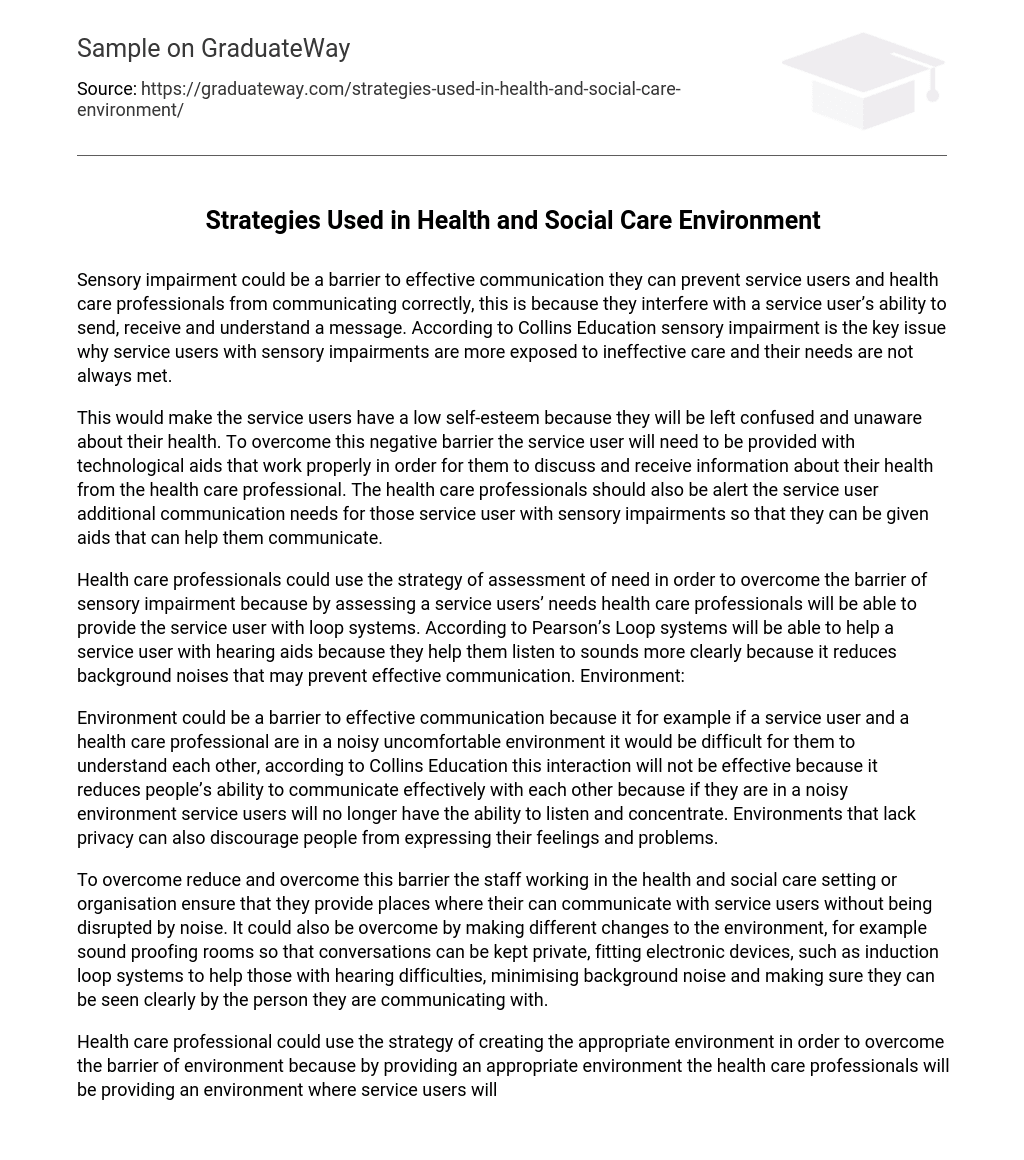According to Collins Education, sensory impairment can hinder effective communication and prevent service users and healthcare professionals from communicating accurately. This is due to the impairment’s interference with a service user’s ability to send, receive, and comprehend messages. Sensory impairments are identified as the main challenge faced by service users with such impairments, making them more susceptible to receiving ineffective care and having their needs unfulfilled.
In order for service users to avoid having low self-esteem and feeling confused or unaware about their health, it is important to provide them with functioning technological aids. These aids will enable service users to discuss and receive information about their health from healthcare professionals. Additionally, healthcare professionals need to be aware of any additional communication needs of service users with sensory impairments. This will allow them to provide necessary aids to aid communication for these individuals.
The strategy of assessing service users’ needs can be employed by health care professionals to address the barrier of sensory impairment. This approach allows for the provision of loop systems to the service users. As stated by Pearson, loop systems assist individuals with hearing aids by enhancing sound clarity and minimizing background noise, thereby promoting effective communication.
According to Collins Education, the environment can pose as a barrier to effective communication. For instance, if a service user and a healthcare professional are in a noisy and uncomfortable environment, it becomes challenging for them to understand each other. This reduction in effective communication hinders people’s ability to effectively communicate with one another, especially if they are in a noisy setting where service users may struggle to listen and concentrate. Additionally, environments lacking privacy can discourage individuals from freely expressing their feelings and discussing their problems.
To overcome this barrier in communication within health and social care settings, staff ensure they provide designated areas for uninterrupted interaction with service users. They can make modifications to the environment, such as soundproofing rooms for privacy, implementing electronic devices like induction loop systems to assist those with hearing impairments, reducing background noise, and ensuring clear visibility during conversations.
Healthcare professionals can overcome the barrier of environment by creating the right environment. By doing so, they are enabling service users to actively listen and gain a better comprehension of the ongoing discussion.
Additionally, individuals will have a greater sense of engagement during the interaction as they will have the opportunity to discuss confidential matters in a private setting. In health and social care settings, alcohol can complicate effective communication since a service user who is intoxicated may be unable to communicate clearly with a healthcare professional, thus potentially hindering their ability to receive personalized care.
If the service user is unable to effectively communicate their problems to the healthcare professional, it will impede the provision of proper healthcare. To address this issue, a strategy could be implemented where a health and social care professional utilizes an advocate. Stretch states that advocates are crucial in situations where a service user is under the influence of alcohol, as they can effectively communicate on their behalf.
The advocate’s ability to communicate clearly with healthcare professionals and understand their message about the service user helps overcome barriers. Additionally, the advocate can provide feedback to the service user when appropriate, ensuring they are aware of any discussions. This promotes effective communication by reducing mistakes and facilitating comfortable communication between the healthcare professional and an attentive listener.
Disability can create a barrier in communication. For example, if a service user relies on a wheelchair for mobility but lacks wheelchair access at a healthcare facility, it hampers effective communication with healthcare professionals. Such discrimination violates the rights of individuals with disabilities.
For effective communication between service users and healthcare professionals, it is vital that professionals comprehend the needs of the user. Staff training should be provided to familiarize professionals with policies, procedures, and how to meet user rights without discrimination. This is crucial as barriers like physical accessibility issues can impede communication.
For instance, health care professionals can meet the needs of service users who require wheelchair access by providing a ramp for entry to the hospital. Additionally, staff training opportunities enable health care professionals to become more familiar with their responsibilities and expectations. This fosters effective communication and equal treatment of service users, eliminating discrimination. Furthermore, promoting the rights of service users, they gain access to the hospital and can effectively communicate their health concerns with a health care professional.





